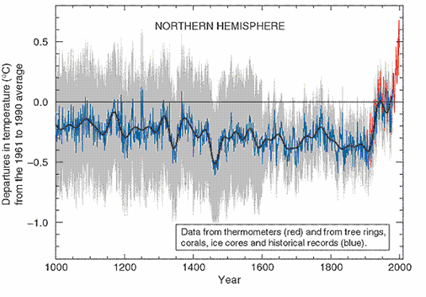

|
 |
2007 May 09
|
Please go to the new Coffee Coaster site implemented more gracefully in Wordpress. Full conversion by 9/12. This page @ http://brianrwright.com/CoffeeCoasterBlog/?p=1476 |
2005, Text Publishing Company, Melbourne, Australia, 315 pages
The paleoclimate record shouts out to us that, far from being self-stabilizing, the Earth's climatic system is an ornery beast which overreacts even to small nudges.
— Wallace Broecker, Cooling the Tropics
A lot of Old Guard liberty sorts, believing in the Infinite Sink and wide open spaces forever (or being susceptible to self-serving oil-cartel propaganda), don't even like the word environmentalism. Let's call it conservation then....
Climate change or global warming, take your pick of phrases, the evidence shows that human-generated carbon dioxide, unchecked, will double by the end of the century, with the likelihood of heating our planet 5°F to 10°F. As stated in Ghostbusters, "That would be bad."
Tim Flannery, a world-renowned scientist, explorer, and conservationist, was initially skeptical of the global warming thesis. But through observations of changing ancient landscapes—e.g. warm-plant species moving up mountainsides—and scientific journals discussing severe alpine threats broke the ice (no pun intended) for him.
The basic arithmetic for CO2 in the atmosphere:
Before the industrial age the approximate average amount of CO2 in the atmosphere was 280 ppm (parts per million (by mass)), equating to 645 gigatons (billions of tons) of carbon. According to Tim Flannery's book, in the 1990s an average 14.6 gigatons accumulated in the atmosphere each year, half of that from burning fossil fuels. Today the amount of carbon dioxide in the atmosphere is 380 ppm corresponding to 869 gigatons of carbon.
—Page 28, 29
By 2004 his inquiries had turned to fears. The world's leading science journals were full of reports that glaciers were melting 10 times faster than expected, greenhouse gases were reaching levels not seen for millions of years, and species were vanishing seemingly overnight. Increasing extreme weather events and the recent occurrence of several of the hottest years on record sealed his conviction.
Flannery became
an advocate.
Not just any advocate, mind you, one of those exceptional scientific advocates such as Carl Sagan who can write. This book is at once a reference manual you can mark and return to again and again, and an exciting narrative of discovery. He is even clear on matters like alternative energy systems.
Did you know Denmark obtains nearly 25% of its electric power through wind, and the power is owned on a cooperative, distributed basis by the citizens themselves?

Early in his voyage he came across the Keeling Curve, "one of the most wonderful things I've ever seen, for in it you can see the planet breathing." Shown on the right, you see the rise; the concentration for thousands of years before 1900 was approximately 275 parts per million.

The Keeling Curve
is often shown in
conjunction with
what is called the
Hockey Stick, a
graph produced
under auspices of
the Intergovernmental
Panel on Climate Change (IPCC) in 2001. If you go to the Web you'll find a lot of heated discussion on both curves, but mainly on the Hockey Stick because of the uncertainty (suggested by the gray area) of temperatures which were inferred before 1900.
My point of view is the two figures are consistent if the causal model of carbon dioxide as a "greenhouse gas" holds true. I doubt there is any scientific disagreement that carbon dioxide in the atmosphere works to retain radiated heat on the earth's surface.
Then I'm reasonably confident scientists know how much of the CO2 is human-generated... and this anthropogenic CO2, via fossil fuel combustion, is a big enough part of the increased concentration creating most of the warming.
Then if you accept that, as I'm sure most peer-reviewed climate-change scientists do, the nuts are off the buggy! Flannery provides scenario after scenario, case after case of real effects of increased global temperatures. Still, he's hopeful we will become conscious of the problem and solve it... as indeed we seem to have resolved chlorofluorocarbon (CFC) damage to the ozone layer.
This is a fascinating, humane, objective, scientific look at global warming and what we can do simply as people to avoid cataclysmic carbon-driven climate change in this century. I love this book; it contains so many insights I could go on all night. Particularly, he helps us see our atmosphere, our "great aerial ocean," as the most fragile of life sustainers (the equivalent in thickness to the skin on an onion).
Let me leave you with one quote in the What You Can Do department:
"The best evidence indicates that we need to reduce CO2 emissions by 70 percent by 2050. If you own a four-wheel-drive and replace it with a hybrid fuel car, you can achieve a cut of that magnitude in a day rather than half a century...."
Thoughts?
Influence Congress through Downsize DC and
its
Read the Bills Act

Please support the Liberty Dollar in its lawsuit
vs. the US Mint




Read the soon to be updated first edition of the only FS book so far:

 |
 |
|||
| New Pilgrim Chronicles Forum |